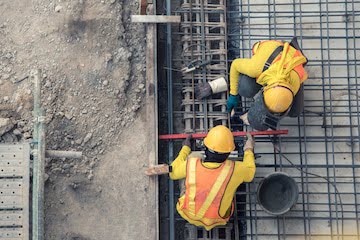This article provides a general overview of the current laws (not regulations) and policies in the UK that relate to health and safety management. This article will be helpful to those how both manage organisations or the safety within organisations.
- Criminal & Civil laws
- The HSE at Work act 1974
- Enforcement of HSE Policy
- Company Directors Disqualification Act 1986
- Corporate Manslaughter Legislation & Examples
1. Criminal & Civil Laws
Laws are written codes of conduct setting rules for individual behaviour for the good of society have existed since Egyptian times, some 3000 years BC.The law is the cement of society and an essential medium for societal change.UK health and safety law is divided into two branches (or systems), civil and criminal which have different purposes. Any given event may give rise to both civil and criminal consequences.Criminal law: if minimum legal standards are not met the enforcing authority may prosecute the offender in the criminal courts.Civil law: if an individual suffers loss (injury / ill-health or death) the victim, or his dependants, may sue for damages (compensation) in the civil courts.Health and safety law – Related Articles
- What is duty of care in regards to contractors?
- UK HSE Enforcement Policy
- 6 steps to effective safety management
Civil and Criminal Consequences
Consider an accident in which an employee cuts off their fingers using an unguarded abrasive wheel.They could take a civil action against their employer, blaming the employer for negligently causing his injury and seeking compensation (damages) for their loss.A criminal prosecution may also be taken by the HSE (assuming the accident was reported, or the HSE was otherwise made aware). The purpose of the prosecution would be to punish the employer (through a fine and/or imprisonment) for failing to comply with relevant health and safety legislation. In this case the guarding requirements of the Provision and Use of Work Equipment Regulations – PUWER.The key differences between civil and criminal law are shown in table 5.| Civil Law | Criminal Law |
| Tort e.g. negligence | Crime e.g. breach of Health and Safety at Work Act or specific regulations |
| Civil wrong | Criminal offence |
| Wrong to an individual | Offence against society |
| Action taken by injured party | Prosecution taken by enforcing authority / Crown Prosecution Service |
| Heard in civil court | Tried in criminal court |
| Loss necessary for action | Loss not necessary |
| Seeks compensation for loss | Seeks to punish for breach of law |
| Liability proved on the “balance of probabilities” | Guilt proven “beyond all reasonable doubt” |
| Can be insured against (Employers Liability Insurance is generally compulsory) | Cannot be insured against fines |
Civil Law
When an employee is injured at work and seeks to make a personal injury claim the employee may sue under the tort of negligence, or the tort of breach of statutory duty.Negligence may be explained as careless conduct injuring another. For the injured party (claimant) to succeed in a negligence claim, he must prove:- That the defendant (usually the employer) owed him a duty of care;
- That this duty was breached; and
- That the claimant was injured as a result of the breach.
The Duty of CarePrior to 1932 there was no generalised duty of care in negligence. The tort (meaning negligence creating liability) was only applied in particular situations where the courts had decided that a duty should be owed, such as road accidents or dangerous goods.In Donoghue v Stevenson (1932) Lord Atkin attempted to lay down a general principle which would cover all the circumstanceswhere there could be liability for negligence.The requirements that must now be satisfied before a duty of care is held to exist were established by Lord Bridge in Caparo Industries v Dickman (1990):
- Foreseeability of the damage, i.e. whether a ‘reasonable person’ would have foreseen damage in the circumstances;
- A sufficiently ‘proximate’ relationship between the parties (i.e. a neighbour relationship); and
- It must be fair, just and reasonable to impose such a duty.
- Employer to employees;
- Employer to contractor and contractors employees; and
- Occupier to authorised visitors.
- A safe place of work and equipment;
- Safe systems of work; and
- Reasonably competent co-workers.
Breach of the Duty of CareThe duty of care is breached if the defendant has failed to exercise the reasonable care expected of a reasonable man in the circumstances.
Breach Caused the InjuryThe claimant must prove, on the balance of probabilities, that the defendant’s breach of duty caused the harm and that the harm would not have occurred “but for” the negligence of the defendant.Other Considerations…Contributory Negligence – Contributory negligence arises when the claimants own carelessness, or disregard for personal safety, contributes to the injury or loss which arises partly because of the claimants own fault and partly because of the fault of another (the defendant). Damages recoverable in respect of the claim will be reduced to the extent the court thinks is fair having regard to the claimant’s share of responsibility for the damage.Vicarious Liability – In general terms vicarious liability is a legal liability imposed on one person making them liable for torts committed by another. With regard to a personal injury claim for an accident in the workplace if an employee, acting in the course of normal employment injures another employee the employer will be held vicariously liable for the losses incurred.Limitations Act 1980 – The Limitation Act 1980 sets a time limit for starting proceedings for claiming compensation for personal injury. This is primarily three years from the date of the negligence that caused the harm, or in the case of disease three years from the date of diagnosis. This primary limit may be extended in the following circumstances: If the injured person is suffering from mental disability then the time limit does not start to run until mental capacity has returned; and
- For minors (under 18 years of age on the date that they were injured) the three year period does not start running until the eighteenth birthday.
- General Damages – Actual and/or probable loss of future earnings, to be incurred after the case; and
- Special Damages – Quantifiable losses incurred before the case, mainly loss of earnings and medical expenses.
- More pre-action contact between the parties;
- Better and earlier exchange of information;
- Better pre-action investigation by both sides;
- Enable cases to be settled fairly and early without litigation; and
- Enable proceedings to run efficiently to the court’s timetable if litigation is necessary.
- Discussion and negotiation;
- Early neutral evaluation by an independent third party; or
- Mediation assisted by an independent neutral party.
2. Health & Safety Act 1974
When considering UK health and safety laws the Health and Safety at Work Act (HASAWA) is the main legislation. It is an Act of Parliament (primary legislation) that prescribes general duties to all at work, regardless of the work activity or context. Failure to comply with a duty under the Act is a criminal offence which may be punished by fine or imprisonment.Regulations – Section 15 of the Health and Safety at Work Act enables the relevant Secretary of State to make health and safety regulations. Regulations (statutory instruments / secondary legislation) are usually more detailed than the general duties of HASAWA and are usually problem specific (e.g. noise, hazardous substances) many regulations were (pre-Brexit) prompted by European Directives. Failure to comply with a Regulation is a criminal offence which may be punished by fine or imprisonment.Key regulations the make up the bulk of UK health and safety laws are;- Manual Handling Regulations
- First Aid at Work regulations
- PUWER Regulations
- LOLER Regulations
- COSHH Regulations
- Data Protection (often referred to as GDPR)
- DSE Regulations (Display Screen Equipment)
- Fire Safety Regulations
- Electrical Safety Regulations
- Managing Health & Safety Regulations
Levels of Legal Duty within the HSE ACTDuties in health and safety law may be absolute (i.e. must be done) or may be qualified. The two major qualifications of health and safety law are those imposed by the phrases ‘practicable’ and ‘reasonably practicable’.Absolute Duties – Usually preceded by the word ‘shall’ an absolute duty must be complied with. The employer has absolute duties to prepare a safety policy and to undertake risk assessments.Practicable – If a duty applies so far as is ‘practicable’ it is a less onerous duty than an absolute one. Practicable means feasible in the light of current knowledge and invention, i.e. if it can be done it must be done.Reasonably Practicable – Reasonably practicable requires the degree of risk (likelihood x severity) of a particular activity or environment to be balanced against the costs (time, trouble and physical difficulty) of taking measures to avoid the risk.The greater the risk, the more likely it is that it will be reasonable to go to very substantial expense, trouble and invention to reduce it.If the consequences and the extent of a risk are small, the same substantial expense would be considered disproportionate to the risk and it would be unreasonable to have to incur them to address a small risk.The size and financial position of the employer are not taken into account in consideration of what is ‘reasonably practicable.’
Health & Safety ACT Objectives
- Securing the health, safety and welfare of people at work; and
- Protecting people other than those at work against risks to their health and safety arising out of work activities.
- Every employer has to ensure, so far as is reasonably practicable, the health, safety and welfare at work of all his employees.
- Examples of the extent of the general duty include (so far as is reasonably practicable):
- The provision and maintenance of plant and systems of work that are safe and without risks to health;
- Arrangements for ensuring health and safety with the use, handling, storage and transport of articles and substances;
- The provision of information, instruction, training and supervision to ensure, the health and safety at work of employees;
- Maintenance of any workplace, under his control, in a healthy and safe condition, including any means of access and egress; and
- The provision and maintenance of a safe and healthy working environment with adequate facilities and arrangements for the welfare of employees at work.
- The means of access or egress; or
- Any plant or substance in such premises.
- That the article or substance is safe and without risks to health when properly used;
- Any necessary research and testing or examination of the article or substance is properly undertaken; and
- Adequate information is provided to ensure its safe use.
- To take reasonable care for the health and safety of himself and of other persons who may be affected by his work ; and
- To co-operate with his employer so far as is necessary to enable the employer to comply with his own duties.
3. Enforcement of Health and Safety
In UK Health and Safety law enforcement depends upon the main activity undertaken at a place of work.The Health & Safety Executive typically enforces at higher risk workplaces such as construction sites and factories.The Office of Rail and Road (ORR) enforces on the railways.Local Authorities (Usually Environmental Health Officers – EHO’s) enforce at lower risk premises such as retailers, offices and warehousing.Powers of Inspectors – All authorised inspectors have the same powers, regardless of the area of enforcement. Inspectors can:- Enter any premises which they think it necessary to enter for the purposes of enforcing health and safety law. The power of entry can be exercised without permission or prior notice, at any reasonable time or at any time if dangerous;
- Take a police constable with them if they have reasonable cause for thinking they might be seriously obstructed;
- Take any other person authorised by their enforcing authority, such as a specialist, and any equipment needed;
- Order that areas be left undisturbed; take measurements, photographs and samples, carry out tests on, and/or confiscate articles and substances; and inspect and take copies of relevant documents;
- Seize any article or substance which they have reasonable cause to believe presents an immediate danger of serious personal injury and have it made harmless, by destruction if necessary; and
- Interview and take written statements from anyone they think might give them information relevant to their examination or investigation.
- Informal advice
- Improvement Notice
- Prohibition Notice
Prosecution
In health and safety law, enforcing authorities will normally prosecute in the public interest, i.e. where, one or more of the following circumstances apply:Death was a result of a breach of the legislation;- The gravity of an alleged offence, taken together with the seriousness of any actual or potential harm, or the general record and approach of the offender warrants it;
- There has been reckless disregard of health and safety requirements;
- There have been repeated breaches which give rise to significant risk, or persistent and significant poor compliance;
- Work has been carried out without or in serious non-compliance with an appropriate licence or safety case;
- A duty holder’s standard of managing health and safety is found to be far below what is required by health and safety law and to be giving rise to significant risk;
- There has been a failure to comply with an improvement or prohibition notice; or there has been a repetition of a breach that was subject to a simple caution;
- False information has been supplied wilfully, or there has been an intent to deceive, in relation to a matter which gives rise to significant risk; and
- Inspectors have been intentionally obstructed in the lawful course of their duties.
4. Company Directors Disqualification Act 1986
In UK health and safety laws the sanction of disqualification for company directors is available to the courts in England, Scotland and Wales under the Company Directors Disqualification Act 1986 (CDDA). An equivalent regime operates in Northern Ireland.The court has the power to make a disqualification order in relation to a person who has been convicted of an indictable offence in connection with the promotion, formation, management, liquidation or striking off of a company, with the receivership of a company’s property or with his being an administrative receiver of a company.In the context of UK health and safety law enforcement and sanctioning, the relevant part is the conviction of an indictable offence “in connection with the management… of a company.”“Management” is interpreted contextually. The court’s jurisdiction will only arise if there is a demonstrable link between:- The offender and the company’s management; and
- The offence itself and the company’s management.
5. Corporate Manslaughter Legislation
Manslaughter by individuals is a ‘common law’ crime. The case of R v Adomako (2005) sets out the current test to prove the offence. An individual commits (involuntary) manslaughter when he causes a death through gross negligence.The test of whether a “company” could be found guilty of common law manslaughter was intrinsically linked to the ‘identification doctrine’. A director or senior manager (a controlling mind and will) of the company had to be found guilty, for the company to be found guilty.There were a number of disasters in the 1980’s and 1990’s which lead to failed prosecutions for corporate manslaughter.The Southall rail crash on 19th September 1997 resulted in 7 deaths and 151 injuries, leading to Great Western Trains (GWT) pleading guilty to contravening Section 3(1) of the Health and Safety at Work Act, and receiving a record fine of £1.5 million.Mr Justice Scott-Baker expressed his concern regarding “a serious fault of senior management”. However a charge of manslaughter could not succeed because no individual could be prosecuted and found guilty of gross negligence manslaughter.The HSE commented that death or personal injury resulting from major disasters was rarely due to the negligence of a single individual but was more likely to be the result of the failure of systems controlling the risk, with the carelessness of individuals being a contributing factor.The Corporate Manslaughter and Corporate Homicide Act 2007After much lobbying to address the shortcomings of prosecutions of corporate bodies under common law the Corporate Manslaughter and Corporate Homicide Act (CMCHA) was introduced to UK health and safety laws in 2007.Under CMCHA, corporate manslaughter:- Can only be committed by organisations and not by individuals;
- Requires a breach of the duty of care under the law of negligence;
- Requires that the breach is a gross breach, i.e. where the conduct of the organisation falls far below what should reasonably be expected;
- Requires that a substantial element in the breach is the way in which the organisation’s activities are managed or organised by its senior management; and
- Is committed only where death is shown to have been caused by the gross breach of duty.
Remedial Orders
Any specific failings involved in the offence ought to have been remedied by the time of sentencing and if not will deprive the defendant of significant mitigation.If, the failings have not been addressed a remedial order may be used if it can be made sufficiently specific to be enforceable.As the remedial order requires only what should already have been done the cost of compliance with the order should not be considered in setting the fine.UK health and safety law enforcement examples:R v Cotswold Geotechnical (Holdings) Ltd. (2011)Cotswold Geotechnical (Holdings) Ltd was found guilty at Winchester Crown Court of the corporate manslaughter charge relating to the death of Alexander Wright, and fined £385 000.Mr Wright aged 27, was working alone in the 12.6ft (3.8m) deep unsupported trial pit when it caved in at a development site near Stroud, Gloucestershire, in September 2008.Under UK health and safety law, the company director Peter Eaton was personal charged with common law gross negligence manslaughter and a breach of section 37 HASAWA. Mr Eaton was seriously ill with cancer and was unable to stand trial.The judge said that Peter Eaton was in substance the company and his approach to trial pitting was “extremely irresponsible and dangerous”.R v JMW Farms Ltd. (Northern Ireland) (2012)Robert Wilson was washing the inside of a large metal bin which was positioned on the forks of a forklift truck. He jumped onto the side of the bin which then toppled. He fell to the ground with the bin falling on top of him resulting in his death. The forklift truck was a replacement for the normal truck which had gone for servicing a number of weeks earlier. The position of the forks on the replacement truck did not correspond with the position of the sleeves on the bin and therefore the bin was unstable.The company was held to be aware of the danger as it had carried out a risk assessment which included instructions for anyone operating the forklift truck. However no assessment had been made of the position of the forks of the replacement truck and the sleeves on the bin.Under UK health and safety law, the Recorder said that the appropriate fine would have been one of £250,000.00. He reduced that by 25% to reflect the plea of guilty. He thereby imposed a fine of £187,500.00. He allowed the company 6 months to pay the fine and the costs of the prosecution (which amounted to £13,000.00 plus 20% VAT).R v Lion Steel Equipment Ltd. (2012)Steven Berry died from his injuries after an accident on 28th May 2008 when he fell through a fragile fibreglass roof panel thirteen metres to the factory floor at the Lion Steel site in Hyde, Cheshire.The company pleaded guilty to the offence on the basis that three directors were not prosecuted for common law manslaughter or section 37 offences.Mr. Berry was expected to go up on the factory roof to make roof repairs, unsupervised, with no training and with no safety equipment such as crawl boards or a fall-arrest harness. The roof, which had been patched up at various times over the previous decades, had no warning notices about fragile sections — despite the firm being warned on this point by an HSE inspector in 2006.Under UK health and safety law, in sentencing Judge Gilbart noted that though the company was in profit, it had substantial loans, the directors were not paying themselves extravagant salaries, and shareholders had not received a dividend for three years.The fine was set at £480 000 but mindful of the jobs of Lion’s 140-strong workforce the judge specified that Lion Steel should be allowed to pay the penalty in four instalments over three years. The prosecution’s claimed costs of £140,000 were reduced to £84,000 and the company were given two years to pay.R v Mobile Sweepers (Reading) Ltd. 2014Malcolm Hinton suffered fatal crush injuries on 6 March 2012, while attempting to repair a hopper on a road sweeper operated by the defendant company Mobile Sweepers (Reading) Limited.The sweeper was elevated from the ground by a hydraulic function but was not propped.Mr Hinton accidentlly cut through a hydraulic hose while attempting the repair and the sudden loss of hydraulic pressure caused the half tonne hopper, to fall back on to the sweeper chassis and crush him.Mobile Sweepers (Reading) Limited ceased trading soon after the fatality and a new company, Owens Sweepers Limited was set up by the company’s sole director, Mervyn Owens around six months later.In response to the issue of businesses being put into administration and subsequently resurrected as new or ‘phoenix’ businesses Mobile Sweepers (Reading) Limited was fined a mere £8 000 whereas Mervyn Owens was fined £183 000 and disqualified under the Company Directors Disqualification Act for five years.Owens was convicted of an offence under section 2 / section 37 of the Health and Safety at Work etc. Act 1974; and a charge of gross negligence manslaughter was left to lie on file.The case is also significant due to the first imposition of a publicity order which was drafted by Judge Boney and published in the legal notices of the Basingstoke Gazette and Newbury Weekly News; on the10th April 2014.Article Ends








